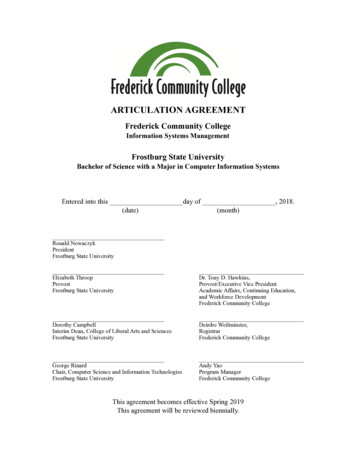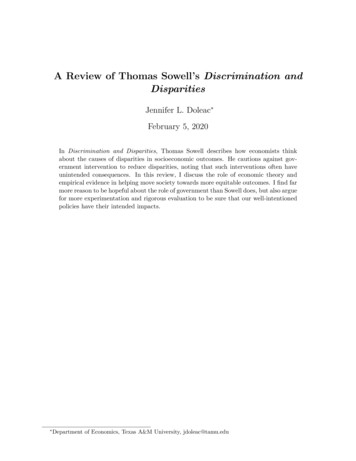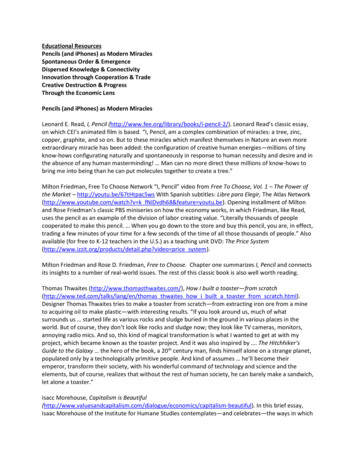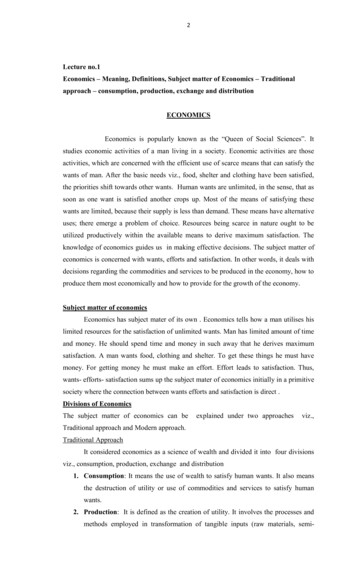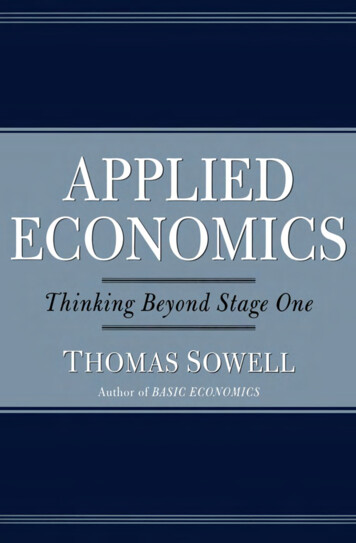
Transcription
This page intentionally left blank
CONTENTSPrefaceix1Politics versus Economics2Free and Unfree Labor313The Economics of Medical Care674The Economics of Housing955Risky Business1276The Economics of Discrimination1617The Economic Development of Nations193Sources2231vii
This page intentionally left blank
PREFACEIt is one thing to know the basic principles of economics. It is another to apply them to the problems of the real world. Yet that isultimately what these principles are all about. Instead of focussingon establishing the principles of economics, as I did in Basic Economics, here the focus will be on dealing in depth with particularreal world problems, using economic principles to clarify why andhow things have happened the way that they have. This is a bookto enable the general reader, with no prior knowledge of economics, to understand some of the key economic issues of our time—medical care, housing, discrimination, and the economicdevelopment of nations, for example. Because these are political, aswell as economic issues, some political principles will need to beconsidered as well. That is, we will need to consider what incentives and constraints apply to political decision-making, as well asthose which apply to economic decisions-making.Neither economics nor politics is just a matter of opinion andboth require thinking beyond the immediate consequences of decisions to their long-term effects. Because so few politicians lookbeyond the next election, it is all the more important that the voters look ahead.It is helpful to have something of a sense of humor when considering economic policies. Otherwise, the study of these policiesand their often painful unintended consequences can get to be toodepressing or you can get too angry. Save your anger until you arein the voting booth on election day. In the meantime, enjoy theprocess of getting more understanding of issues and institutionsthat affect your life and the future of the country.ix
xPrefaceBecause this is a book for the general public, the usual footnotes orendnotes are omitted. However, for those readers who want toverify what is said here, or to read further on some of the subjectscovered, the sources of the many facts discussed here are listed inthe back of the book.THOMAS SOWELLThe Hoover InstitutionStanford University
Chapter 1Politics versus EconomicsWhen we are talking about applied economic policies, we areno longer talking about pure economic principles, butabout the interactions of politics and economics. The principles ofeconomics remain the same, but the likelihood of those principlesbeing applied unchanged is considerably reduced, because politicshas its own principles and imperatives. It is not just that politicians’ top priority is getting elected and re-elected, or that theirtime horizon seldom extends beyond the next election. The general public as well behaves differently when making political decisions rather than economic decisions. Virtually no one puts asmuch time and close attention into deciding whether to vote forone candidate rather than another as is usually put into decidingwhether to buy one house rather than another—or perhaps evenone car rather than another.The voter’s political decisions involve having a minute influenceon policies which affect many other people, while economicdecision-making is about having a major effect on one’s own personal well-being. It should not be surprising that the quantity andquality of thinking going into these very different kinds of decisions differ correspondingly. One of the ways in which thesedecisions differ is in not thinking through political decisionsbeyond the immediate consequences. When most voters do not1
2APPLIED ECONOMICSthink beyond stage one, many elected officials have no incentive toweigh what the consequences will be in later stages—andconsiderable incentives to avoid getting beyond what their constituents think and understand, for fear that rival politicians candrive a wedge between them and their constituents by catering topublic misconceptions.The very way that issues are conceived tends to be different inpolitics and in economics. Political thinking tends to conceive ofpolicies, institutions, or programs in terms of their hoped forresults—“drug prevention” programs, “profit-making” enterprises,“public-interest” law firms, “gun control” laws, and so forth. Butfor purposes of economic analysis, what matters is not what goalsare being sought but what incentives and constraints are being created in pursuit of those goals. We know, for example, that many—if not most—“profit-making” enterprises do not in fact makeprofits, as shown by the high percentage of new businesses that goout of business within a few years after being created. Similarly, itis an open question whether drug prevention programs actuallyprevent or reduce drug usage, whether public interest law firms actually benefit the public, or whether gun control laws actually control guns. No economist is likely to be surprised when rent controllaws, for example, lead to housing shortages and fail to controlrent, so that cities with such laws often end up with higher rentsthan cities without them. But such outcomes may be very surprising to people who think in terms of political rhetoric focussed ondesirable goals.The point is not simply that various policies may fail to achievetheir purposes. The more fundamental point is that we need toknow the actual characteristics of the processes set in motion—andthe incentives and constraints inherent in such characteristics—rather than judging these processes by their goals. Many of the“unintended consequences” of policies and programs would have
Politics versus Economicsbeen foreseeable from the outset if these processes had been analyzed in terms of the incentives and constraints they created, instead of in terms of the desirability of the goals they proclaimed.Once we start thinking in terms of the chain of events set in motion by particular policies-and following these events beyond stageone—the world begins to look very different.Politics and the market are both ways of getting some people torespond to other people’s desires. Consumers choosing whichgoods to spend their money on have often been analogized tovoters deciding which candidates to elect to public office. However, the two processes are profoundly different. Not only doindividuals invest very different amounts of time and thought inmaking economic versus political decisions, those decisions areinherently different in themselves. Voters decide whether to votefor one candidate or another but they decide how much of whatkinds of food, clothing, shelter, etc., to purchase. In short, politicaldecisions tend to be categorical, while economic decisions tend tobe incremental.Incremental decisions can be more fine-tuned than decidingwhich candidate’s whole package of principles and practices comesclosest to meeting your own desires. Incremental decision-makingalso means that not every increment of even very desirable things islikewise necessarily desirable, given that there are other things thatthe money could be spent on after having acquired a given amountof a particular good or service. For example, although it might beworthwhile spending considerable money to live in a nice home,buying a second home in the country may or may not be worthspending money that could be used for sending a child to college orfor recreational travel overseas. One consequence of incremental decision-making is that increments of many desirable things remainunpurchased because they are almost—but not quite—worth thesacrifices required to get them.3
4APPLIED ECONOMICSFrom a political standpoint, this means that there are always numerous desirable things that government officials can offer to provide to voters who want them—either free of charge or atreduced, government-subsidized prices—even when these votersdo not want these increments enough to sacrifice their own moneyto pay for them. Ultimately, of course, the public ends up payingas tax-payers for things that they would not have chosen to payfor as consumers. The real winners in this process are thepoliticians whose apparent generosity and compassion gain thempolitical support.In trying to understand the effect of politics on economics, weneed to consider not only officials’ responses to the various pressures they receive from different sources, but also the way that themedia and the voting public see economic issues. Both the mediaand the voters are prone to what might be called one-stagethinking.ONE-STAGE THINKINGWhen I was an undergraduate studying economics under Professor Arthur Smithies of Harvard, he asked me in class one day whatpolicy I favored on a particular issue of the times. Since I hadstrong feelings on that issue, I proceeded to answer him with enthusiasm, explaining what beneficial consequences I expected fromthe policy I advocated.“And then what will happen?” he asked.The question caught me off guard. However, as I thought aboutit, it became clear that the situation I described would lead to othereconomic consequences, which I then began to consider and tospell out.“And what will happen after that?” Professor Smithies asked.
Politics versus EconomicsAs I analyzed how the further economic reactions to the policywould unfold, I began to realize that these reactions would lead toconsequences much less desirable than those at the first stage, andI began to waver somewhat.“And then what will happen?” Smithies persisted.By now I was beginning to see that the economic reverberationsof the policy I advocated were likely to be pretty disastrous—and,in fact, much worse than the initial situation that it was designedto improve.Simple as this little exercise may sound, it goes further thanmost economic discussions about policies on a wide range of issues. Most thinking stops at stage one. In recent years, formereconomic advisers to presidents of the United States—from bothpolitical parties—have commented publicly on how little thinkingahead about economic consequences went into decisions made atthe highest level. 1 This is not to say that there was no thinkingahead about political consequences. Each of the presidents theyserved (Nixon and Clinton) was so successful politically that hewas re-elected by a wider margin than the vote that first put him inoffice.Incentives and ConsequencesThinking beyond stage one is especially important when considering policies whose consequences unfold over a period of years. Ifthe initial consequences are good, and the bad consequences comelater—especially if later is after the next election—then it is alwaystempting for politicians to adopt such policies.1Herbert Stein and Joseph Stiglitz5
6APPLIED ECONOMICSFor example, if a given city or state contains a number of prosperous corporations, nothing is easier than to raise money to financelocal government projects that will win votes for their sponsors byraising the tax rates on these corporations. What are thecorporations going to do? Pick up their factories, hotels, rail-roads,or office buildings and move somewhere else? Certainly notimmediately, in stage one. Even if they could sell their local properties and go buy replacements somewhere else, this would taketime and not all their experienced employees would be willing tomove suddenly with them to another city or state. Nevertheless,even under such restrictions on movement, the high taxes wouldbegin to have some immediate effect.Businesses are always going out of business and being replacedby new businesses that arise. In high-tax cities and states, there islikely to be an increase in the rate at which businesses go out ofbusiness, as some struggling firms that might have been able to holdon longer, and perhaps ride out their problems, are unable to do sowhen heavy tax burdens are added to their other problems.Meanwhile, newly arising companies have options when decidingwhere to locate their factories or offices, and cities and states withhigh tax rates are likely to be avoided. Therefore, even if all existingand thriving corporations are unable to budge in the short run, thehigh-tax jurisdictions can begin the process of losing businesses,even in stage one. But the losses may not be on a scale that is largeenough to be noticeable.Then comes stage two. Usually the headquarters where abusiness’ top brass work can be moved before the operating unitsthat have larger numbers of employees and much equipment.Moreover, if the corporation has other operating units in other citiesand states—or perhaps overseas—it can begin shifting some of itsproduction to other locations, where taxes are not so high, even if itdoes not immediately abandon its factories or offices at given sites.This reduction in the amount of business done locally in the hightax location will in turn begin to reduce the locally earned income
Politics versus Economicson which taxes are paid by both the corporation and its localemployees.Stage three: As corporations grow over time, they can choose tolocate their new operations where taxes are not so high, transferring employees who are willing to move and replacing those whoare not by hiring new people. Stage four: As more and more corporations desert the high-tax city or state, eventually the point canbe reached where the total tax revenues collected from corporationsunder higher tax rates are less than what was collected under thelower rates of the past, when there were more businesses payingthose taxes. By this time, however, years may have passed and thepoliticians responsible for setting this process in motion may wellhave moved on to higher office in state or national government.More important, even those politicians who remain in office inthe local area are unlikely to be blamed for declining tax revenues,lost employment, or cutbacks in government services and neglectedinfrastructure made necessary by an inadequate tax base. In short,those responsible for such economic declines will probably escapepolitical consequences, unless either the voters or the media thinkbeyond stage one and follow the sequence of events over a period2of years—which seldom happens.2there is another sense in which multiple stages must be taken into account, which may beeasier to explain by analogy. Imagine that a dam can be emptied into a valley and thatcalculations show that this would fill the valley with water to a depth of 20 feet. If your home islocated on an elevation 30 feet above the valley floor, it should be safe if the water is slowlyreleased. But if the floodgates are simply flung wide open, a wave of water 40 feet high may roaracross the valley, smashing your home and drowning everyone in it. After the water subsides, itwill still end up just 20 feet deep, but that will not matter as far as the destruction of the homeand people are concerned, even though both are now 10 feet above the level at which the watersettles down. A Nobel Prize-winning economist has argued that economic policies suddenlyimposed on various Third World countries by the International Monetary Fund have ignoredthe timing and sequence of reactions inside those countries, which may include irreparabledamage to the social fabric as economic desperation creates mass riots that can topplegovernments and make foreign investors unwilling to put money into such an unstable countryfor years to come.7
8APPLIED ECONOMICSNew York City has been a classic example of this process. Oncethe headquarters of many of the biggest corporations in America,New York in the early twenty-first century was headquarters to justone of the 100 fastest growing companies in the country With thehighest tax rate of any American city and the highest real estate taxper square foot of business office space, New York has been losingbusinesses and hundreds of thousands of jobs. Meanwhile, the cityhas been spending twice as much per capita as Los Angeles andthree times as much per capita as Chicago on a wide variety ofmunicipal programs. By and large, spend-and-tax policies havebeen successful politically, however negative their economic consequences.In short, killing the goose that lays the golden egg is a viable political strategy, so long as the goose does not die before the nextelection and no one traces the politicians’ fingerprints on the murder weapon. Looking at it in another sense, when you have agentsor surrogates looking out for your interests, in any aspect of life—political or otherwise—there is always the danger that they willlook out for their own interests, which do not always coincide withyours. Corporate managements do not always put the stockholders’interest first, and agents for actors, athletes, or writers may sacrificetheir clients’ interests to their own. There is no reason to expectelected officials to be fundamentally different. But there arereasons to know what their incentives are—and what the economicrealities are that they may overlook while pursuing their own political goals.Such one-stage thinking is not peculiar to the United States orto tax issues. On the other side of the world, an Indian writer observed the same phenomenon as regards education reform:No one bothers about education because results take a long time tocome. When a politician promises rice for two rupees (12 cents a
Politics versus Economicspound) when it costs five rupees in the market (31 cents a pound), hewins the election. N. T. Rama Rao did precisely that in the 1994state elections. He won the election, became the chief minister, andnearly bankrupted the state treasury. He also sent a sobering message to Prime Minister Narasimha Rao in Delhi, who, according tosome observers, slowed India’s reforms because he realized thatvotes resided in populist measures and not in doing what is right forthe long run. Since the 1980s politicians have competed in givingaway free goods and services to voters. When politicians do that,where is the money to come from for creating new schools or improving old ones?I became thoroughly depressed the day the Punjab chief minister,Prakash Singh Badal, gave away free electricity and water to farmers inFebruary 1997. He had lived up to his electoral promises, but twelvemonths later the state’s fragile finances were destroyed and therewas no money to pay salaries to civil servants.Like taxes, subsidies also have further repercussions that canmake the country as a whole worse off, even when the subsidies arenot paid for out of the government’s treasury but are created byhaving one good or service subsidize another. Subsidized train farein India, for example, are paid for by raising freight charges. Nodoubt this wins more votes among passengers than the votes lostamong shippers, simply because there are likely to be far morepassengers. However, the economic result of these artificially highfreight charges, according to the distinguished British magazineThe Economist, is that “power plants in the south of India find itcheaper to import coal from Australia than to buy it from Bihar”Meanwhile, Bihar is one of the poorest states in India and couldvery much use additional jobs in its coal industry.Even when dealing with emergency situations, public officialsmay think of themselves and their own political needs before they9
10APPLIED ECONOMICSthink of the victims and their plight. According to Indian economist Barun Mitra: “The super cyclone that hit the coasts of easternIndian state of Orissa in November 1999, left more than 10,000people officially dead. But unofficial reports continued to put thefigure at more than double that number. There were reports in themedia that the Central Government in Delhi was reluctant to seekinternational help, because this in some way might be a reflectionon the competence of the national government. And this despitethe fact that even two weeks after the tragedy, many villages remained cut-off without any information coming or relief reachingthe survivors”What about the reaction of a market economy to such a disaster?Few insurance companies could drag their feet like this and expectto survive in a competitive economy, because people would switch tobuying the policies of some rival insurance company. But mostgovernment agencies are monopolies. If you don’t like the slow response of a government emergency relief agency, there is no rivalgovernment emergency relief agency that you can turn to instead.Monopoly tends toward self-indulgent inefficiency, whether it is aprivate monopoly or a government monopoly. The difference isthat monopoly is the norm for government agencies, while fewprivate businesses are able to prevent rival firms from arising tochallenge them for customers.Those who think no further than stage one often regard thegovernment’s power to control prices as a way of reducing the costsof various goods and service, thus making them more widelyafford-able. Such policies as “bringing down the cost ofprescription drugs” or making housing “affordable” often seem veryattractive when thinking no further than stage one. However, evenin stage one, there is a fundamental difference between trulybringing down the costs of particular goods and services and simplyforbid-ding prices from reflecting those costs.
Politics versus EconomicsA classic example of controlling prices without controlling costswas the electricity crisis in California in 2001 and 2002. The costsof generating the electricity used by Californians rose substantiallyfor a number of reasons. Reduced rainfall on the west coast meantreduced water flow through hydroelectric dams and consequentlyless electricity was generated there. Since the costs of running thesedams did not fall correspondingly, this meant that the cost ofgenerating a given amount of electricity rose. At the same time, thecosts of such fuels as oil and natural gas were also rising, so that thecosts of generating electricity in these ways was also in-creasing. Inthe normal course of events, such rising costs would have beenreflected in higher prices on California consumers’ electric bills,which would provide incentives for those consumers to reducetheir use of electricity. But California politicians came to theirrescue by imposing legal limits on how high electricity prices wouldbe permitted to rise. That was stage one.While those who generated electricity passed on their costswhen they sold the electricity wholesale to the public utility companies, which directly supplied the public, these public utilitieswere forbidden to charge the public more than the legally prescribed price. Thus when wholesale electricity prices were 15 centsper kilowatt hour, the retail price remained at 7 cents per kilowatthour. As an economic study of the industry put it:Wholesale prices signaled that electricity was increasingly scarce,but retail prices told consumers that nothing had changed.Accordingly, consumers demanded more electricity than wasavailable.Blackouts were the inevitable result. That was stage two. Stagethree saw California politicians scrambling to find some way tostop the blackouts, which not only disrupted homes and businessescurrently, but threatened to drive some businesses out of the state,11
12APPLIED ECONOMICSwhich would deprive California of both jobs and taxes. Worse yet,from the politicians’ perspective, it threatened their re-electionprospects. Stage four saw California public utility companies goingbankrupt, as they bought electricity from wholesalers at higherprices than they were allowed to charge their customers. Thepublic utilities’ lack of money and declining credit ratings then ledthe wholesalers to refuse to continue supplying them withelectricity. Things were now truly desperate, so the governorstepped in and used the state’s money to buy the electricity that thewholesalers would not sell to the financially strapped utility companies on credit.In the end, Californians paid more for their electricity—onlypartly on their electric bills and the rest on their tax bills or in reduced government services as the state’s record budget surplusturned into a record deficit. It is doubtful whether Californianspaid a dime less after the politicians’ grandstand rescue of themwith price controls than they would have paid had the state government stayed out of it and let the price be determined by supplyand demand. When all the costs are counted, they may well haveended up paying more than they would have if the increased costshad simply led to higher prices through the marketplace. But thegovernor was re-elected.In general outlines, none of this was unique to California or toelectricity. Price controls have been causing shortages in countriesaround the world, and for literally thousands of years of recordedhistory, whether the prices that were being controlled were theprices of food, housing, fuel, medical care, or innumerable othergoods and services. Almost all these price controls were popularwhen they were first instituted because most people did not thinkbeyond stage one. After imposing the first peacetime wage andprice controls in American history, President Richard Nixon wasre-elected in a landslide, even though he had been elected initiallyby a very narrow margin.
Politics versus EconomicsAnother major difference between private and governmental institutions is that, no matter how big and successful a private business is, it can always be forced out of business when it is no longersatisfying its customers—whether because of its own inadequaciesor because competing firms or alternative technologies can satisfythe customers better. Government agencies, however, can continueon despite demonstrable failures, and the power of government canprevent rivals from arising.Despite innumerable complaints about the U. S. Postal Serviceover the years, it continues to maintain a monopoly so strict that itis illegal for anyone else to put things in a citizen’s mailbox, eventhough that mailbox was bought and paid for by the citizen, ratherthan by the government. Postal authorities clearly understand whata competitive threat it would be to them if the public had a choiceof private companies delivering mail to their homes. Privatepackage-delivery companies like United Parcel Service and FederalExpress have long ago overtaken the Postal Service in the numberof packages delivered. Indeed, federal government agenciesthemselves often prefer to rely on private package-deliverycompanies.RecyclingPrices play many roles in allocating time and effort, as well asgoods and services. Recycling, for example, requires time and effort, and the incremental value of the things being recycled may ormay not be worth the time and effort spent in salvaging them.Where the incremental value of the salvaged goods is greater thanthe value of the alternative uses of the time and effort, recyclingcan take place spontaneously, as a result of the ordinary operationsof a free m a r k e t without laws or exhortations. There are somesalvageable things whose incremental value would lead to their being recycled without government intervention and other salvage-13
14APPLIED ECONOMICSable things whose incremental value would lead to their beingthrown away. Recycling is not categorically justified or unjustified,but is incrementally either worth or not worth the costs.In some Third World countries, or among the chronically unemployed or homeless population in affluent countries like the UnitedStates, it may make perfect sense to collect discarded cans andbottles to sell—and some people do so voluntarily, without beingforced or exhorted to do so. In mid-twentieth century West Africa,a distinguished British economist named Peter Bauer noted the“extensive trade in empty containers such as kerosene, cigarette andsoup tins, flour, salt, and cement bags and beer bottles” Althoughmany third-party European observers at that time regarded suchAfrican recycling activities as wasteful uses of labor becauseEuropeans did not spend their time doing such things, ProfessorBauer explained why it was not wasteful:Some types of container are turned into various household articles orother commodities. Cigarette and soup tins become small oil lamps,and salt bags are made into shirts or tunics. But more usually thecontainers are used again in the storage and movement of goods.Those who seek out, purchase, and carry and distribute secondhand containers maintain the stock of capital. They pre-vent thedestruction of the containers, usually improve their condition,distribute them to where they can best be used, and so extend theirusefulness, the intensity of their use, and their effective life. Theactivities of the traders represent a substitution of labour for capital.Most of these African recyclers were women and children, andthe meager alternative employment open to them made it efficientfor them to make a small profit on recycled containers, when thatprofit exceeded what they could earn elsewhere. It was also moreefficient for the society as a whole: “So far from the system being
Politics versus Economicswasteful it is highly economic in substituting superabundant forscarce resources”— t h e superabundant resource being the time ofotherwise idle labor.Both when recycling was criticized in mid-twentieth centuryAfrica and exhorted in late-twentieth century America, third-partyobservers simply assumed that they had superior under-standingthan that of the people directly involved, even though theseobservers had seldom bothered to think through the economics ofwhat they were saying. At some point it pays virtually everyone torecycle and at some other point it pays virtually no one. What iscrucial is the value of the thing being recycled and the value of thealternative uses of resources, including the time of the people whomight do the recycling.Even in an affluent country such as the United States, camerashave long be
It is one thing to know the basic principles of economics. It is an-other to apply them to the problems of the real world. Yet that is ultimately what these principles are all about. Instead of focussing on establishing the principles of economics, as I did in Basic Eco-nomics, here the focus will be on dealing in depth with particular





